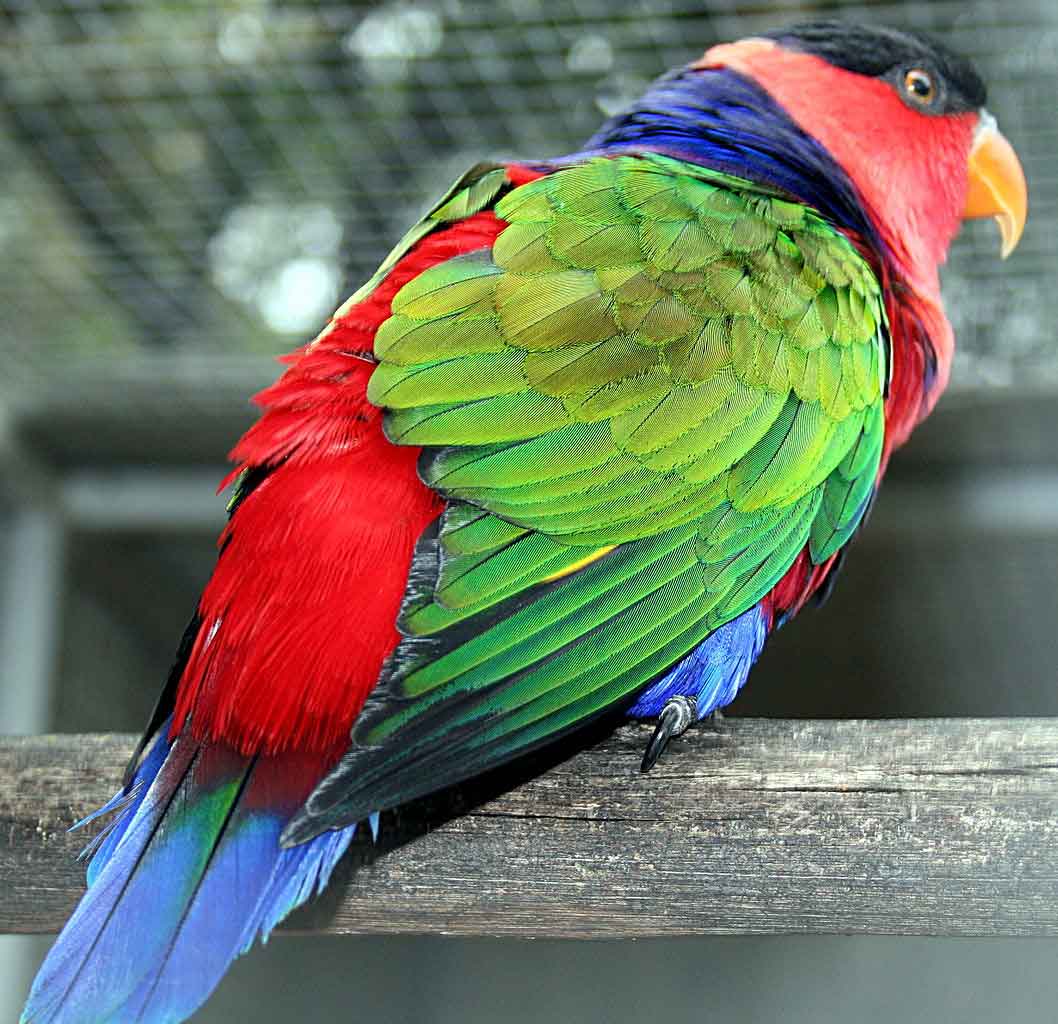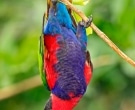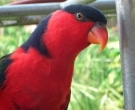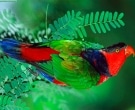Content |
|---|
Description
The Black-capped Lory (Lorius lory) has an approximate length of 31 cm.. and a weight between 200 and 260 g..
Black hood extends above the peak to the nape of the neck, where a few blue spots appear; rest of the head is bright red. The black hood is separated from the rear mantle red pink (sometimes mottled red), by a fine necklace of dark purple blue; back, the upper coverts bright red tail and rump.
Upper parts of green color with slight shine bronze wing, more visible on the coverts and secondary more internal.
Flight feathers of black on the inside and marked with yellow in the middle part, forming the group a tricolour in the Underwing. Red Wing coverts.
Throat and upper part of the chest of Red; Blue mantle extends around the sides of the chest, dark blue in the abdomen that is slightly brighter in thighs and coverts; flanks with varying amounts of Red ranging upward and around the curve of the wing.
Dark bluish black on the upper tail feathers, Green slightly sieved in the Centre and Red at the base (It shows only dark blue at rest); Yellow undertail dark Olive with red hidden base.
Orange peak; Cere and grey-black periophthalmic ring; orange-yellow IRIS; grey to black legs.
Males and females they are the same. Immature with less extensive blue underparts and the upper part of the chest of color red wine. Fine blue collar around throat. Underwing coverts blue and yellow with a black tip, not red as in adults. Brownish beak.
Subspecies vary considerably in color:
- Lorius lory lory: It is the nominal
- Lorius lory erythrothorax: Neck and central area of blue belly. Yellow in the wings. Blue mantle in two bands. Red Underwing coverts.
- Lorius lory SOMU: Red neck, blue belly.
- Lorius lory salvadorii: As the erythrothorax but with blue-black Underwing coverts.
- Lorius lory viridicrissalis: As the salvadorii but the blue darker everywhere.
- Lorius lory jobiensis: As the salvadorii but top of the paler breast and mantle bands.
- Lorius lory cyanuchen: Black on the top with blue on the nape of the neck.
- Sound of the Black-capped Lory.
Habitat:
The Black-capped Lory he prefers the primary forests and edges of these, They also reported in secondary forests well grown, in some partially cleared areas and swamp forest. It is not known to occur in the monsoon forest, planted forests or plantations of coconut trees. The Black-capped Lory is mainly distributed in the lowlands up to 1.000 m, but there have been examples to 1.750 m.
They are mainly found in pairs and usually smaller than other groups parrots sympatric, but it may happen that they get together in groups of ten or more to feed in trees in flower.
Reproduction:
Little is known of its breeding ecology in the wild., Although there is a history of a couple digging a pit to make the nest in a dead tree. Apparently the nesting occurs from the month of may until October.
In captivity, the setting is two eggs with 26 incubation days; emancipation occurs between 57 and 70 days after hatching.
Food:
The diet includes pollen, nectar, flowers, fruits and insects. The birds prefer to feed in the canopy or half-height where they remain quiet and discrete. Unlike in the Coconut Lorikeet and the Dusky lory, It reached generally similar maximum altitudes, This species has been able to adapt to secondary habitats in high levels in the East of New Guinea.
Distribution:
Widely distributed from the West of Irian Java (Indonesian), including Waigeo, Batanta, Salawati and Misool in the Group of islands west of papua and Yapen, My Num. They are also found in the Biak island on bahía de Geelvink, (It is from Papua New Guinea).
It is quite common in the lowlands and foothills.. Top world population to the 100.000 individuals.
Subspecies distribution:
- Lorius lory lory: It is the nominal.
- Lorius lory erythrothorax: The South coast of New Guinea east of the peninsula Bird’s Head, and to the southeast of the North Coast.
- Lorius lory SOMU: Mountain districts in the South of the center of New Guinea.
- Lorius lory salvadorii: Northwest Coast of Papua New Guinea.
- Lorius lory viridicrissalis: Northeast coast of Western New Guinea.
- Lorius lory jobiensis: Islands Yapen and My Num.
- Lorius lory cyanuchen: Biak Island.
Conservation:
• Current IUCN Red List category: Least concern
• Population trend: Stable
The world's population has not been quantified, but the species has been observed that it is, usually, common, but not abundant throughout its area of distribution.
Suspected that the population is stable in the absence of evidence of any reduction or substantial threats.
"Black-capped Lory" in captivity:
It has attractive voice and can learn to imitate. Playful and curious; It can be noisy at times.
Common up to the decade of 1960 When exports began to cease.
Alternative names:
– Black-capped Lory, Black capped Lory, Tricolored Lory, Tricoloured Lory, Western Black-capped Lory (ingles).
– Lori tricolore, Lori à calotte noire (French).
– Frauenlori (German).
– Lóris-bailarino (Portuguese).
– Lori Tricolor, Tricogloso Tricolor (español).
scientific classification:
– Order: Psittaciformes
– Family: Psittaculidae
– Scientific name: Lorius lory
– Citation: (Linnaeus, 1758)
– Protonimo: Psittacus Lory
Images “Black-capped Lory”:
Videos "Black-capped Lory"
————————————————————————————————
“Black-capped Lory” (Lorius lory)
Sources:
– Avibase
– Parrots of the World – Forshaw Joseph M
– Parrots A Guide to the Parrots of the World – Tony Juniper & Mike Parr
– Birdlife
– Photos:
1 – By Michael Spencer [CC BY 2.0], via Wikimedia Commons
2 – “Lorius lory – Bird Park, Singapore – upside down-8a” by Benjamint444 – Own work. Licensed under GFDL 1.2 via Wikimedia Commons.
3 – “Lorius lory-20051118” by Doug Janson – Own work. Licensed under CC BY-SA 3.0 via Wikimedia Commons.
4 – By René Modery (originally posted to Flickr as CIMG6207) [CC BY 2.0], via Wikimedia Commons
5 – VJ Czar World – Black-capped Lory Snapshots
– Sounds: Frank Lambert (Xeno-canto(







I have enough experience in the breeding of birds say q commercial table eggs hens and chickens for human vonsumo I love birds exotic have lory but I don't have the time to take care of it properly by the complexity of their feeding esiste a comrcial food to feed q provide the management? Please if the answer is positive to say I type and brand